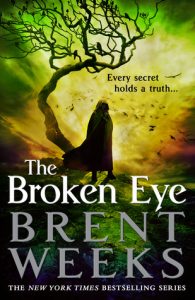The Broken Eye by Brent Weeks
 Brent Weeks’ Lightbringer series was one of my favourite discoveries of 2013. The second book in the series, The Blinding Knife, won that year’s Legend award, and for very good reason: it was fast-paced, full of great characters, and continued to develop the unique and fascinating magic system on which the entire series is based. This high standard, then, might be why The Broken Eye – Lightbringer #3 – left me feeling a little flat.
Brent Weeks’ Lightbringer series was one of my favourite discoveries of 2013. The second book in the series, The Blinding Knife, won that year’s Legend award, and for very good reason: it was fast-paced, full of great characters, and continued to develop the unique and fascinating magic system on which the entire series is based. This high standard, then, might be why The Broken Eye – Lightbringer #3 – left me feeling a little flat.
Don’t get me wrong: I enjoyed The Broken Eye, quite a lot actually. The pacing is still fast, the characters are still great, and the magic system – light spectrum-based ‘drafting’ – is still creative and fun. However, despite the fast pace – which is accelerated rather than stunted by the alternating points of view – there were some sections of the book which felt kind of aimless and/or disjointed (Blackguard training exercises, I’m looking at you!). There were some parts that had me skipping back to previous chapters to see if I’d missed something, such as Kip appearing at the Chromeria despite the fact that he was lost in the wilderness the last time we saw him.
Another gripe I have about The Broken Eye is the language. There are quite a few Americanisms used, particularly during Kip’s chapters; perhaps these are simply more noticeable to a non-American reader, but personally I found that some of the modern phrasing felt somewhat jarring. Some of Kip’s internal monologues, most of which worked well in conveying his youth and social awkwardness, sometimes felt a little too forced and child-like, and ended up feeling kind of patronising, making me cringe internally for all the wrong reasons. Again, though, that may just be me.
As for the rest of the book, it made a valiant attempt to live up to the high standard set by its predecessor. The chapters alternate between several characters with whom we’re now very familiar – Kip, Karris, Gavin, Teia and the rest – and often focuses on one character for a long period of time, which gives us the opportunity to really get involved in the different storylines. Gavin in particular has a great storyline in this book, partly because of his involvement with the brilliant character Gunner, and Teia has also become a very prominent player. There are also several one-off POVs slotted into the story at intervals, some of which are more entertaining than others: most are written in first person (in contrast to the third person narrative forming the bulk of the novel) and are intended to be disorienting, but happen so infrequently that they serve to disrupt the story rather than embellish it. Others are so enjoyable to read that it’s a disappointment to realise they’re only a one-off, such as the chapter focusing on Arys Greenveil.
With regards to the story, The Broken Eye is sadly nowhere near as full of twists and turns as the first two books seemed to be, although it does contain one HUGE twist at the end which almost rivals the one in The Black Prism. We also don’t seem to learn as much about the magic system as we did in previous books, especially as Kip is no longer attending magic classes. However, the author compensates for this by expanding Teia’s role in the story, and chooses to focus on the creative and sometimes sinister ways in which she is finally able to explore her own special drafting ability.
In the end, I found The Broken Eye a lot more enjoyable and entertaining than the bulk of this review suggests. Personally, though, I think the Lightbringer series may have peaked too soon with The Blinding Knife.
